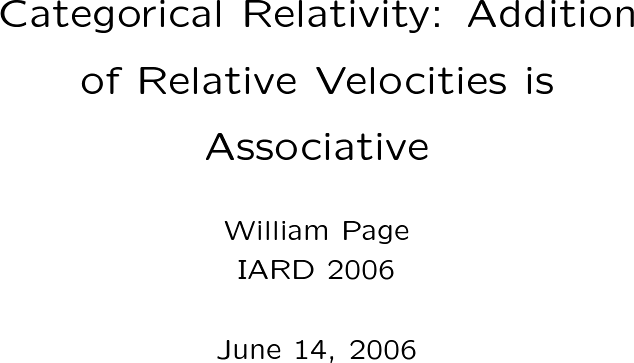|
|
1
2
|
|
Editor:
Time: 2007/11/18 18:33:41 GMT-8
|
|
Note:
|
changed:
-
\documentclass{slides}
\usepackage{latexsym,amssymb,amsmath,amsfonts,amscd,amsthm,amstext}
\newcommand{\bk}{\Bbbk}\newcommand{\Z}{\mathbb{Z}}
\newcommand{\C}{\mathbb{C}}\newcommand{\R}{\mathbb{R}}
\newcommand{\N}{\mathbb{N}}\newcommand{\Q}{\mathbb{Q}}
\newcommand{\La}{\mathcal{L}}\newcommand{\F}{\mathcal{F}}
\newcommand{\ie}{\textit{i.e.}\,}
\newcommand{\alg}{\operatorname{alg}}
\newcommand{\Mod}{\operatorname{mod}}
\newcommand{\obj}{\operatorname{obj}}
\newcommand{\iso}{\operatorname{iso}}
\newcommand{\cat}{\text{cat}}
\newcommand{\tr}{\operatorname{tr}}
\newcommand{\cotr}{\operatorname{cotr}}
\newcommand{\ev}{\text{ev}}
\newcommand{\coev}{\operatorname{coev}}
\newcommand{\im}{\operatorname{im}}
\newcommand{\End}{\operatorname{End\,}}
\newcommand{\id}{\operatorname{id}}
\newcommand{\Span}{\operatorname{span}}
\newcommand{\gen}{\operatorname{gen}}
\newcommand{\ra}{\longrightarrow}
\newcommand{\Fr}{\operatorname{Fr}}
\newcommand{\der}{\operatorname{der}}
\newcommand{\grade}{\operatorname{grade}}
\newcommand{\half}{\textstyle{\frac{1}{2}}}
\newcommand{\g}{\mathfrak{g}}
\usepackage[dvips]{graphicx}
\newcommand{\digraph}[2][scale=1]{%
\IfFileExists{#2.ps}%
{\includegraphics[#1]{#2}}%
{\fbox{
\begin{tabular}{l}
The file \texttt{#2.ps} hasn't been created from
\texttt{#2.dot} yet.
\end{tabular}
}
}
\writedigraph{#2}}
\def\writedigraph#1#2{%
\newwrite\dotfile
\immediate\openout\dotfile=#1.dot
\let\n\relax%define it.
\expandafter\def\csname -\endcsname{\string\n}
\immediate\write\dotfile{digraph #1 {#2}}
\immediate\closeout\dotfile}
\begin{document}
\title{Categorical Relativity: Addition of Relative Velocities is Associative}
\author{William Page\\
IARD 2006}
\date{June 14, 2006}
\maketitle
Introduction
Categorical relativity employs a category consisting of objects representing massive bodies
(observers) and morphisms (arrows) that represent the relative velocity of one body (target)
with respect to another (source).
\newpage
Category Theory
Deals with abstract mathematical structures and relationships between them. Categories appear
in most branches of mathematics and have been employed in computer science and mathematical
physics. Category theory presents a unified languange and set of concepts that cross the
boundries between many diverse and initially distinct subjects. Categories were first
introduced by Samuel Eilenberg and Saunders Mac Lane in 1945, in connection with algebraic
topology.
Instead of focusing on objects possessing a specific structure, category theory emphasizes
the morphisms — the structure-preserving processes — between these objects.
We don't need much from category theory to begin applying it to relativity!
\newpage
Relative Velocity
Unlike Lorentz boosts, pairs of relative velocities may be composed (added) only if the
source of the first velocity matches the target of the second. Composition of relative
velocities is associative.
The categorical structure of relative velocities matches our common intuition
about velocity and is equally applicable to Galilean Relativity.
\newpage
Relativity
Minkowski introduced the concept of (binary) relative velocity $v$ in 1908 in the context
of the special Lorentz transformations.
Zbigniew Oziewicz with Darius Swierk (thesis) considered addition of relative velocity
in 1988.
\begin{equation}
Q = \gamma (P + v/c)
\end{equation}
for P, Q time-like 4-vectors (obsrvers) where $\gamma=-P \cdot Q$
\begin{description}
\item[Tamas Matolcsi (1993)]{\
Spacetime without Reference Frames}
\item [Daniel Gottlieb (1997)]{\
http://arxiv.org/abs/q-alg/9603024}
\end{description}
\newpage
Observers P and Q determine different Euclidean subspaces
\begin{equation}
\{u \in M | P \cdot u = 0\} \ne \{u' \in M | Q \cdot u' = 0\}
\end{equation}
Inverse Velocity
\begin{equation}
v = Q/\gamma - P
\end{equation}
\begin{equation}
v' = P/\gamma - Q
\end{equation}
\begin{equation}
v \ne -v'
\end{equation}
Lorentz Boost (Matolcsi)
\begin{equation}
L(P,Q) \cdot v' = -v
\end{equation}
\begin{equation}
L(P,Q) \cdot Q = P
\end{equation}
\newpage
Addition (Matolcsi, Oziewicz)
\begin{equation}
w = R/\gamma - Q
\end{equation}
with $\gamma=-Q \cdot R$
\digraph{RelativeVelocity1}{rankdir=LR; P->Q [label="v"]; Q->R [label="w"]; Q->P [label="v'"]; P->R [label="w + v"]; }
$w + v =$
\begin{equation}
= \frac{( w - \frac{w \cdot v'}{v'^2} v ) \sqrt{1 - v'^2} + (1 - \frac{w \cdot v}{v^2}) v }{1 - w \cdot v'}
\end{equation}
\begin{equation}
= \frac{\gamma v + w}{\gamma(1-\frac{w \cdot v'}{c^2})} + \frac{w \cdot v'}{c(1-\frac{w \cdot v'}{c^2})} P
\end{equation}
All inner products are defined within Euclidean subspace.
Hyperbolic geometry is not necessary (Oziewicz).
\end{document}
\begin{latex}
\digraph{RelativeVelocity1}{rankdir=LR; P->Q [label="v"]; Q->R [label="w"]; Q->P [label="v'"]; P->R [label="w + v"]; }
\end{latex}

![\digraph{RelativeVelocity1}{rankdir=LR; P->Q [label="v"]; Q->R [label="w"]; Q->P [label="v'"]; P->R [label="w + v"]; }
\digraph{RelativeVelocity1}{rankdir=LR; P->Q [label="v"]; Q->R [label="w"]; Q->P [label="v'"]; P->R [label="w + v"]; }](images/734116276377595875-16.0px.png)